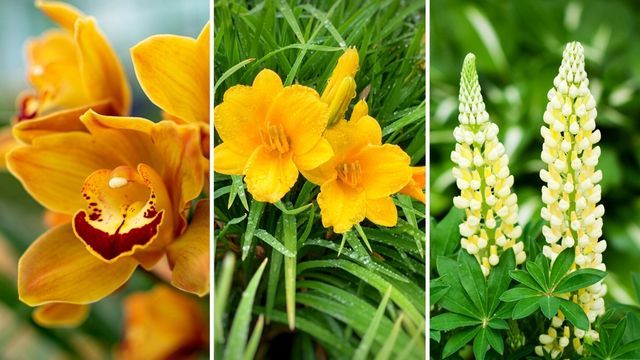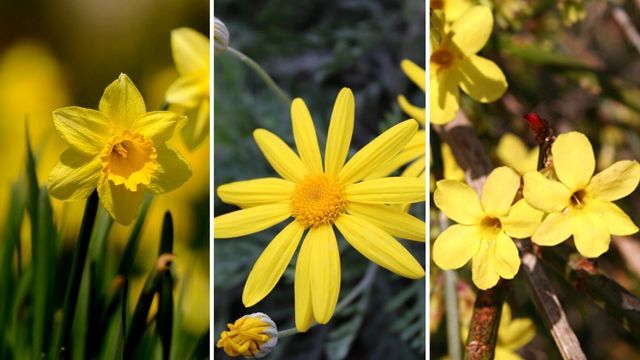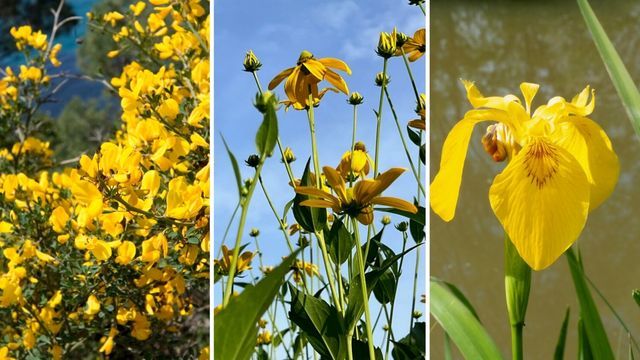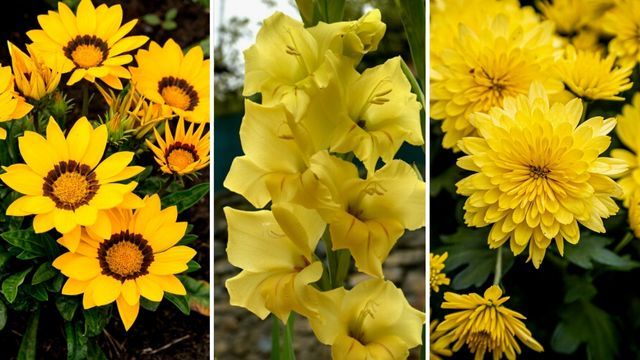Table of contents
If you're in this article it's because you love yellow plants and, no wonder, bring light, life and a lot of warmth to the garden area in which they are located.
We hope that you will discover below many names of plants with yellow flowers that you didn't know about until now and include them in your collection. We show you a total of 27 varieties beautiful!
Yellow flowers: names and photos
Phlomis russeliana
The Phlomis russeliana develops medium-sized green leaves that will last practically all year round. Unlike other perennials that lose their leaves in winter, this one keeps them.
Once the spring The flowers begin to develop flower stalks that, as they grow in height, develop spheres of yellow flowers.
Hypericum calycinum
The Hypericum calycinum is a shrub that develops a spectacular growth of yellow flowers of medium size in summer.
It is also known as creeping hypericum or St. John's wort and is used as a groundcover plant. It is very resistant and keeps its leaf practically all year round, although it loses it slightly in winter.
 From left to right: Phlomis russeliana, Hypericum calycinum and Kerria japonica.
From left to right: Phlomis russeliana, Hypericum calycinum and Kerria japonica.
Kerria japonica
The Kerria japonica is a shrub that begins to develop a large amount of yellow flowers in late winter with hardly any leaves.
Although the shrub is not excessively dense, it has a beautiful ethereal aesthetic. Its branches are very voluminous, take up a lot of space, but are very light.
Yellow cymbidium orchid
The Cymbidium orchid is distinguished by having a bush of very erect green leaves from which the flowering stems sprout.
It is a very showy plant for its colorful and fragrant flowers of various colors such as green, brown, red, white, green and yellow, our protagonist today. Flowers once a year for 2-3 months in the season from winter to spring.
Hemerocallis or Day Lily
This perennial plant is unique! Golden Hemerocallis Stella is a very rustic plant native to Mexico. Its common name is "Daylily". refers to the fact that its small yellow flower only lasts one day.
This variety of Hemerocallis is usually the most compact and is one of the most floriferous, with three flowering peaks in the summer.
 From left to right: Yellow cymbidium orchid, Hemerocallis or daylily and Lupinus chandelier.
From left to right: Yellow cymbidium orchid, Hemerocallis or daylily and Lupinus chandelier.
Lupinus chandelier
The Lupinus chandelier is a perennial plant that develops beautiful yellow flowers and creates large spike-like inflorescences. Its flowering period is from June to the end of August.
Having a very vertical stem and flowers on the stem itself, the latter stand out in the flowerbed giving color and joy to the composition in which it is located. You can see it in this flowerbed of yellow flowering perennials.
Alchemilla mollis
The Alchemilla mollis or lion's foot is a perennial plant that attracts attention because of its small yellow flowers Its leaves, on the other hand, have a mercury effect, that is, as the leaves have a series of small hairs, the water remains on the leaf as a drop of mercury.
Mimosa
If there is a plant that cheers up the gray winters by filling them with color and scent, that is the Mimosa. Because of the shape of its leaves and the way they develop, it is sometimes mistaken for a shrub, but it is a very vigorous medium-sized tree.
Common Mimosa or Acacia Dealbata develops beautiful yellow flowers in the form of small sphere balls that flood everything with their sweet and pleasant fragrance.

Golden Rod
The Goldenrod or Solidago canadensis is a herbaceous perennial plant characterized by its yellow flower buds that almost look like gold, hence its common name. Its flowering period occurs in spring and summer.
In addition to being decorative, this yellow wildflower is known for its diuretic, depurative, anti-inflammatory and medicinal properties....
Yellow daffodil
Daffodil bulbs or Narcissus They remain dormant throughout the summer and, in autumn, begin to develop leaves. It is in late winter-early spring when they give us their beautiful flowers that can be pure white, a wide gradation of yellows and oranges and, on rare occasions, pink.
Euryops pectinatus
The Euryops pectinatus The yellow daisy or gray daisy, is an outdoor plant that blooms all year round except in summer (its peak season is in spring). It is a spectacle to enjoy these yellow flowers in the field or planted in pots.
The yellow daisy is a compact and rounded plant, with a woody habit, which can reach a height of one and a half meters.
 From left to right: Narcissus, Euryps pectinatus, and Jasminum nudiflorum.
From left to right: Narcissus, Euryps pectinatus, and Jasminum nudiflorum.
Jasminum nudiflorum
The Jasminum nudiflorum also known as winter jasmine, yellow jasmine, and St. Joseph's jasmine, brings out all its charm during the season when there is less floral activity.
This variety is a winter-flowering climber, and as soon as it starts to flower, it is a real beauty! It develops a large number of yellow flowers that last until spring. It's an explosion of color in the garden!
Yellow buttercup
Buttercups are plants of about twenty centimeters high that are bloom in late winter-early spring after planting the bulbs in autumn, and remain in bloom until summer.
Buttercups can have yellow flowers, like all the ones we present today, white, orange, pink, red and purple flowers thanks to the hybridization and selection of bulbs.
Surfinia yellow
The surfinia is a variety of petunia much more vigorous and whose flowering lasts longer from spring to early autumn or the beginning of the first frosts.
Within the group of surfinias, we can find flowers of different colors: pink, yellow, lime...
 From left to right: Ranunculus, surfinia and Thunbergia or Susana black eyes.
From left to right: Ranunculus, surfinia and Thunbergia or Susana black eyes.
Thunbergia alata
The Thunbergia alata also known as black-eyed Susanna, is a climbing plant that blooms from mid-summer to autumn. flowers as their common name suggests, are yellow with a characteristic black eye in the center .
Yellow dahlia
The dahlia or Dhalia is a tuberous plant whose showy flowers emerge from its decorative foliage from mid-summer until the first autumn frosts. The flower can be yellow, red, pink, purple and white.
Depending on the variety, its height can vary from a few centimeters above the ground to more than one meter in height.
Bidens yellow
The best known variety of Bidens is the one that has the yellow flower petals but some have emerged with more orange tones.
It is a variety that behaves as a short cycle perennial plant: will live about 2 to 3 years After the vegetative period, in the yellow flowers, seeds will appear that we can use to reproduce our own plants.
 From left to right: dahlia, bidens and Sanvitalia
From left to right: dahlia, bidens and Sanvitalia
Sanvitalia
Sanvitalia procumbens or Ojo de gallo is a perennial herbaceous plant with a creeping habit with small yellow flowers These, which emerge in summer, have a brown center and small, oval, green leaves.
It is ideal to be planted in the garden or in pots as in this floral composition with hakonechloa for shady areas.
Lantana sellowiana
The Lantana sellowiana repens, lantana montevidensis or creeping is a perennial plant very resistant to both drought and short periods of frost.
It is very floriferous! Its yellow, purple and white flowers remain throughout the year, but fade in the frosty season. It is a species of lantana smaller than the one known as Lantana camara.
Mahonia charity
Mahonia charity is a very elegant shrub. It can reach a height of two to two and a half meters and has very serrated lanceolate leaves that, like holly, end in spikes.
From the crown, yellow flower stalks will begin to emerge, which will adorn the bush during the winter and provide a very peculiar aroma.
 From left to right: Lantana sellowiana, Mahonia charity and Tagetes patula.
From left to right: Lantana sellowiana, Mahonia charity and Tagetes patula.
Tagetes patula yellow flower
The Tagete patula is one of the flowering plants protagonists of the spring-summer season It is often confused with the variety of Tagete erecta Its flowers can be yellow, red, orange and even bicolor.
Genista
The Genista is a shrub known as cytisus It has a rounded shape and can reach a meter in height.
If there is one thing that completely stands out about it, it is its flowering. yellow flowers will remain in spectacular form throughout spring and summer (These flowers are terminal, that is, they will appear in the last zone of the plant, and their leaves are trifoliate, three similar leaves come out of the same stem.
Rudbeckias herbstonne
The Rudbeckias herbstonne are plants with stems that can reach two meters in height.
They have a very intense yellow petals in the shape of daisies When it loses its petals, seed heads appear, which are also very ornamental.
 From left to right: Genista, Rudbeckias herbstonne and Iris pseudacorus.
From left to right: Genista, Rudbeckias herbstonne and Iris pseudacorus.
Iris pseudacorus
The Iris pseudacorus or yellow iris is a very beautiful national variety of water lily. Its flowers are yellow and its petals are smaller than those of the Japanese Iris, or Iris japonica (This difference in plant flowering time is key to keeping a pond alive throughout the year.
Yellow gazania
The gazania is a very hardy plant that does not require much care. It is in bloom almost all year round, especially in warm climates, although it usually blooms from spring to late summer.
A curiosity of these plants is that its flowers They can be yellow, pink, orange, red or even bicolor, are closed every night to reopen during the day.
Yellow Gladiolus
The gladiolus is a plant very appreciated in gardening for its diversity of colors. Its flowers can be yellow, red, maroon, green, coral or pink and are ideal for creating bouquets and floral arrangements.
This plant develops from a corm, similar to a bulb, which is planted in early spring. It can also be planted in early summer to extend flowering.
 From left to right: Gazania, gladiolus and chrysanthemum.
From left to right: Gazania, gladiolus and chrysanthemum.
Chrysanthemum yellow
While some plants need good weather, high temperatures and lots of sun, others, such as the Chrysanthemum, bloom with the arrival of autumn. You can find flowers in a wide range of colors: white, orange, purple, yellow...
It is often used as a flower for All Saints' Day and this plant is loaded with symbols.

